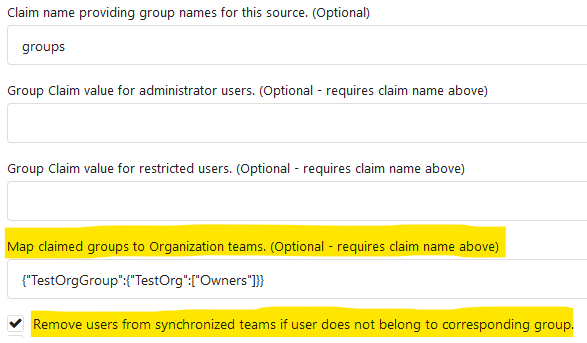`KeyID` is never set.
(cherry picked from commit 155269fa586c41a268530c3bb56349e68e6761d7)
Conflicts:
models/user/email_address.go
trivial context conflict
Part of #27065
This reduces the usage of `db.DefaultContext`. I think I've got enough
files for the first PR. When this is merged, I will continue working on
this.
Considering how many files this PR affect, I hope it won't take to long
to merge, so I don't end up in the merge conflict hell.
---------
Co-authored-by: wxiaoguang <wxiaoguang@gmail.com>
Fixes https://github.com/go-gitea/gitea/issues/22676
Context Data `IsOrganizationMember` and `IsOrganizationOwner` is used to
control the visibility of `people` and `team` tab.
2871ea0809/templates/org/menu.tmpl (L19-L40)
And because of the reuse of user projects page, User Context is changed
to Organization Context. But the value of `IsOrganizationMember` and
`IsOrganizationOwner` are not being given.
I reused func `HandleOrgAssignment` to add them to the ctx, but may have
some unnecessary variables, idk whether it is ok.
I found there is a missing `PageIsViewProjects` at create project page.
To avoid duplicated load of the same data in an HTTP request, we can set
a context cache to do that. i.e. Some pages may load a user from a
database with the same id in different areas on the same page. But the
code is hidden in two different deep logic. How should we share the
user? As a result of this PR, now if both entry functions accept
`context.Context` as the first parameter and we just need to refactor
`GetUserByID` to reuse the user from the context cache. Then it will not
be loaded twice on an HTTP request.
But of course, sometimes we would like to reload an object from the
database, that's why `RemoveContextData` is also exposed.
The core context cache is here. It defines a new context
```go
type cacheContext struct {
ctx context.Context
data map[any]map[any]any
lock sync.RWMutex
}
var cacheContextKey = struct{}{}
func WithCacheContext(ctx context.Context) context.Context {
return context.WithValue(ctx, cacheContextKey, &cacheContext{
ctx: ctx,
data: make(map[any]map[any]any),
})
}
```
Then you can use the below 4 methods to read/write/del the data within
the same context.
```go
func GetContextData(ctx context.Context, tp, key any) any
func SetContextData(ctx context.Context, tp, key, value any)
func RemoveContextData(ctx context.Context, tp, key any)
func GetWithContextCache[T any](ctx context.Context, cacheGroupKey string, cacheTargetID any, f func() (T, error)) (T, error)
```
Then let's take a look at how `system.GetString` implement it.
```go
func GetSetting(ctx context.Context, key string) (string, error) {
return cache.GetWithContextCache(ctx, contextCacheKey, key, func() (string, error) {
return cache.GetString(genSettingCacheKey(key), func() (string, error) {
res, err := GetSettingNoCache(ctx, key)
if err != nil {
return "", err
}
return res.SettingValue, nil
})
})
}
```
First, it will check if context data include the setting object with the
key. If not, it will query from the global cache which may be memory or
a Redis cache. If not, it will get the object from the database. In the
end, if the object gets from the global cache or database, it will be
set into the context cache.
An object stored in the context cache will only be destroyed after the
context disappeared.
Fixes #19555
Test-Instructions:
https://github.com/go-gitea/gitea/pull/21441#issuecomment-1419438000
This PR implements the mapping of user groups provided by OIDC providers
to orgs teams in Gitea. The main part is a refactoring of the existing
LDAP code to make it usable from different providers.
Refactorings:
- Moved the router auth code from module to service because of import
cycles
- Changed some model methods to take a `Context` parameter
- Moved the mapping code from LDAP to a common location
I've tested it with Keycloak but other providers should work too. The
JSON mapping format is the same as for LDAP.

---------
Co-authored-by: Lunny Xiao <xiaolunwen@gmail.com>
- Currently the function `GetUsersWhoCanCreateOrgRepo` uses a query that
is able to have duplicated users in the result, this is can happen under
the condition that a user is in team that either is the owner team or
has permission to create organization repositories.
- Add test code to simulate the above condition for user 3,
[`TestGetUsersWhoCanCreateOrgRepo`](a1fcb1cfb8/models/organization/org_test.go (L435))
is the test function that tests for this.
- The fix is quite trivial use a map keyed by user id in order to drop
duplicates.
---------
Co-authored-by: Lunny Xiao <xiaolunwen@gmail.com>
Change all license headers to comply with REUSE specification.
Fix #16132
Co-authored-by: flynnnnnnnnnn <flynnnnnnnnnn@github>
Co-authored-by: John Olheiser <john.olheiser@gmail.com>
Fix #19513
This PR introduce a new db method `InTransaction(context.Context)`,
and also builtin check on `db.TxContext` and `db.WithTx`.
There is also a new method `db.AutoTx` has been introduced but could be used by other PRs.
`WithTx` will always open a new transaction, if a transaction exist in context, return an error.
`AutoTx` will try to open a new transaction if no transaction exist in context.
That means it will always enter a transaction if there is no error.
Co-authored-by: delvh <dev.lh@web.de>
Co-authored-by: 6543 <6543@obermui.de>
A lot of our code is repeatedly testing if individual errors are
specific types of Not Exist errors. This is repetitative and unnecesary.
`Unwrap() error` provides a common way of labelling an error as a
NotExist error and we can/should use this.
This PR has chosen to use the common `io/fs` errors e.g.
`fs.ErrNotExist` for our errors. This is in some ways not completely
correct as these are not filesystem errors but it seems like a
reasonable thing to do and would allow us to simplify a lot of our code
to `errors.Is(err, fs.ErrNotExist)` instead of
`package.IsErr...NotExist(err)`
I am open to suggestions to use a different base error - perhaps
`models/db.ErrNotExist` if that would be felt to be better.
Signed-off-by: Andrew Thornton <art27@cantab.net>
Co-authored-by: delvh <dev.lh@web.de>